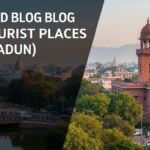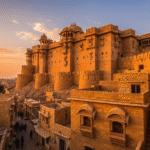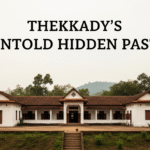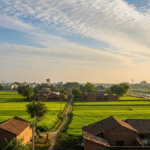Did you know Imphal is a hidden gem in culture and history? It’s in Manipur and often missed by many. The local attire is more than just clothes. It tells the rich story of its people. Through it, we see their resilience, spirituality, and creativity. This makes learning about Manipuri attire very special.
Key Takeaways
- Manipuri traditional dress reflects the region’s ethnic diversity and cultural richness.
- Each piece of clothing has deep historical and cultural significance.
- Manipuri ethnic clothing incorporates unique natural fibers and traditional weaving techniques.
- Popular costumes include Phanek for women and Dhoti for men.
- Festivals and ceremonies prominently feature these traditional attires.
- Contemporary designers are adding modern twists to traditional styles.
- Efforts are underway to preserve Manipuri traditional attire through artisanal and government support.
Introduction to Manipuri Traditional Attire
Manipuri clothing is bright and beautiful. It shows the rich culture of Manipur. The clothes are well-made, with vivid colors and natural materials.
Each clothing piece is very special. They show Manipur’s social life and values. Women wear the Phanek, a colorful skirt. Men wear a Dhoti and Kurta for honor and respect. These clothes are a big part of daily life and celebrations.
Learning about this attire shows its deep meaning. Artisans make each piece with great care. These clothes are central to festivals, showing Manipur’s unique beauty.
So, Manipuri attire is a reflection of the area’s rich culture. It tells stories of the people’s values and spirit.
Historical Significance of Manipuri Traditional Dress
The history of Manipuri dress is a rich cultural journey. It goes back centuries, starting with the Indus Valley Civilization. This old civilization showed us early weaving methods. They grew cotton and made simple fabrics. These were the early days of the Manipur traditional dress.
During the Mughal era, clothes became fancier. Silks and cottons were loved by the rich. This time added fine details and great skill to Manipuri fashion. The tradition of handloom weaving grew. Every piece told a story of who you were and where you came from.
After independence, there was a push to keep these traditions alive. Efforts were made to bring back handloom weaving. This celebrated Manipuri clothes and their unique handmade quality. Men and women worked together. They kept the old ways that families had passed down.
Now, Manipuri clothes are more than just outfits. They show the culture, strength, and teamwork of the community. They fit well with today’s ideas of sustainable fashion. This dress’s history makes the people of Manipur very proud.
Fabric and Textiles Used in Manipuri Ethnic Clothing
Manipuri traditional dress shows the depth of culture through its fabrics. Natural fibers like cotton, silk, and Eri silk show the craftspeople’s hard work. Each cloth tells a story of Manipuri heritage.
Types of Natural Fibers
Several natural fibers make Manipuri clothes beautiful and special. Here are the key ones:
- Cotton: It’s breathable and comfy, perfect for daily wear.
- Silk: Silk is soft and fancy, saved for big events and fancy outfits.
- Eri silk: This silk is special to the area. It’s tough and shiny.
Traditional Weaving Techniques
Local craftspeople use age-old weaving methods. These skills make Manipuri clothing unique and keep culture alive. Important methods include:
- Handloom weaving: This makes every piece special and shows off the weaver’s talent.
- Ikat: In this method, threads are dyed before weaving. This makes complex designs that make fabrics stand out.
Secrets of the Manipuri Traditional Attire
The Manipuri traditional attire is full of rich cultural meanings and unique looks. Each garment has a story, showing the values and beliefs of the Manipuri people. Exploring these secrets, one finds the close link between fashion and who we are.
Cultural Symbolism Behind Each Garment
Every piece of Manipuri costume has its own special symbolism. Women’s saris, for instance, show grace and status, telling if a woman is married. Different designs are for various events, making them more than just clothes. Men’s clothes like the dhoti and kurta carry cultural importance too. They are often worn during rituals, connecting today with past traditions.
Color Palettes and Patterns
Color is key in Manipuri clothing, with each shade having a meaning. Bright colors show happiness and celebrations, while soft tones reflect nature and peace. Patterns and designs tell personal and spiritual stories. For example, lotus designs mean purity and wisdom, important in local beliefs. Knowing these elements helps understand Manipuri attire’s rich culture.
Popular Manipuri Traditional Costumes
In Manipuri ethnic clothing, both men and women’s outfits are special. They are known for their beauty, skill in making, and cultural value. We will look at two important types of traditional clothes. They show the bright and rich culture of Manipur.
Women’s Traditional Costumes: Phanek and Innapak
The Phanek is key in Manipuri women’s dress. It’s a skirt that wraps around. It comes in beautiful fabrics with bright colors and detailed designs. It can be styled in many ways for different occasions. The Innapak is worn with the Phanek. It makes the outfit more elegant. It’s often decorated with fine embroidery, showing the talent of local craftspeople.
Men’s Attire: Dhoti and Kurta Variations
The Dhoti is important in Manipuri men’s fashion. It wraps around the waist. It’s comfy and stylish. The Dhoti looks good with Kurtas. Kurtas can be simple for day-to-day wear or fancy for special events. Both show the same amazing weaving and colorful designs as other Manipuri clothes.
| Costume Type | Description | Cultural Significance |
|---|---|---|
| Phanek | A wrap-around skirt worn by women | Symbol of femininity and regional pride |
| Innapak | Overlay worn with Phanek | Represents traditional artistry and elegance |
| Dhoti | Wrap-around cloth tied at the waist | Represents heritage and cultural traditions |
| Kurta | Long tunic worn with Dhoti | Blends comfort with cultural expression |
Manipuri Cultural Attire in Festivals and Ceremonies
Manipuri cultural attire is very important during festivals and ceremonies. It shows the area’s rich traditions. Events like Lai Haraoba and Ningol Chakouba show the colorful traditional dress. It’s a beautiful scene with music, dance, and rituals. The clothes are more than just outfits. They are symbols of cultural pride.
Key Festivals Celebrating Manipuri Dress
Many festivals celebrate Manipuri dress. Each one shows different parts of the culture. The colors and patterns mean different things. They are all deeply traditional. Some important festivals are:
- Lai Haraoba: A festival honoring the deities, featuring dance performances and ornate costumes.
- Ningol Chakouba: A family festival where married women are gifted traditional dresses, highlighting their significance in Manipuri society.
- Yaoshang: Celebrated with games, music, and beautiful attire, merging cultural elements with community spirit.
Rituals and Traditions Involving Costume
Manipuri attire rituals are varied. Each ceremony tells a story. They show cultural values through special costumes. Some key rituals include:
- Offering prayers in traditional garments, aligning divine grace with cultural expression.
- Participating in traditional dances in vibrant attire, highlighting celebration joy.
- Family gatherings where clothes symbolize unity and respect for traditions.
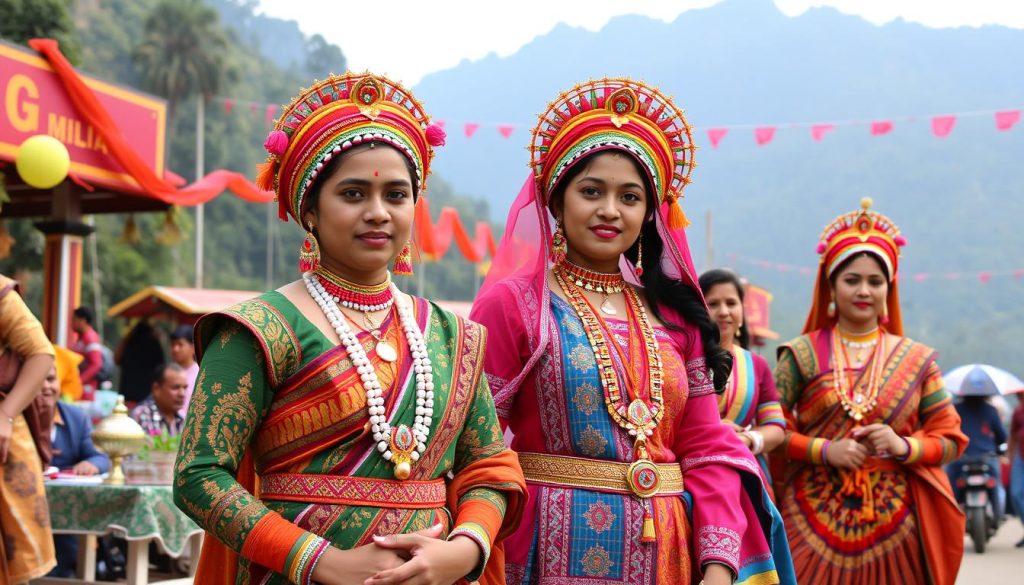
| Festival | Significance | Traditional Attire |
|---|---|---|
| Lai Haraoba | Spiritual celebration honoring deities | Colorful Phanek and Innapak for women; Dhoti and Kurta for men |
| Ningol Chakouba | Celebration of marital bonds | Traditional sarees for women and ethnic wear for men |
| Yaoshang | Community festivities involving games | Festive wear showcasing local craftsmanship |
Modern Adaptations of Manipuri Traditional Fashion
Modern Manipuri fashion mixes old and new styles. Today’s designers blend tradition with new trends. They use bright colors and unique designs. This mix keeps Manipuri culture alive in today’s fashion.
Influence of Contemporary Designers
Today’s designers are key in updating Manipuri clothes. They try new things with materials and designs. This brings young people to appreciate tradition while keeping it modern. Famous brands now include Phanek and Innapak inspired clothes. This has made these traditional items popular again.
Fusion Styles in Urban Fashion
Fusion styles make Manipuri fashion versatile. Traditional fabrics meet global trends here. This mix creates stylish outfits for any event. Traditional Manipuri patterns and western elements blend smoothly. This creates a new look that is becoming popular in cities. It merges the past and present while staying fashionable.
Where to Buy Authentic Manipuri Traditional Clothing
If you love authentic Manipuri ethnic clothing, you have many places to look. You can find these traditional outfits in busy local markets or online. This gives you a great chance to dive into the beautiful culture and craft of these clothes.
Local Markets and Craft Fairs
Visiting local markets and craft fairs is a fantastic way to buy Manipuri clothes. In Imphal, the Khwairamband Bazar is a famous spot. Artisans there show off their beautiful fabrics and handmade clothes. You can enjoy the lively place and talk directly with the weavers.
Local craft fairs also have a lot of Manipuri clothes. They show off special designs. You can learn about how people in the area make these clothes, too.
Online Retailers Specializing in Ethnic Attire
If you can’t go in person, you can shop online for these clothes. Sites like iTokri let you buy handmade clothes from artisans all over India. This site cares about the earth and being fair. So, each piece really shows the skill and traditions of Manipuri textiles.
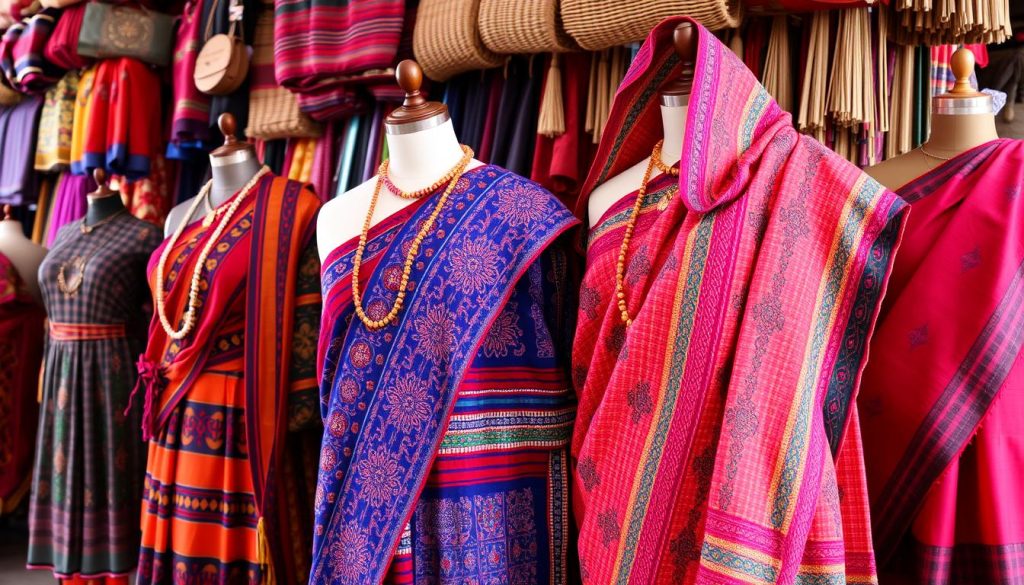
| Retailer Type | Description | Key Benefits |
|---|---|---|
| Local Markets | Physical stores showcasing artisanal work and traditional textiles. | Direct interaction with artisans, vibrant atmosphere, and unique finds. |
| Online Retailers | Websites dedicated to selling ethnic clothing from various regions. | Convenience, wider selection, and support for sustainable practices. |
Preservation of Manipuri Traditional Attire
Keeping Manipur’s traditional clothes alive is important. It helps preserve the state’s rich culture. Local artisans are key in this. They ensure that the unique designs and weaving survive. Their work allows new generations to enjoy Manipuri attire as art.
Efforts from Local Artisans
Artisans in Manipur work hard to keep their craft alive. They use old techniques learned from family. Doing this keeps the community and its identity strong. They also use eco-friendly methods, like natural dyes.
Government Initiatives for Cultural Preservation
The government sees the value in preserving these clothes. They’ve started programs to help local artisans. They offer money and promote public understanding. This helps everyone see the beauty of Manipur’s attire.
| Initiative | Description |
|---|---|
| Artisan Support Programs | Financial assistance for artisans to promote traditional crafts. |
| Cultural Festivals | Events celebrating Manipuri attire and its significance. |
| Public Awareness Campaigns | Educating the public about the importance of ethnic attire. |
| Collaboration with Designers | Encouraging partnerships between artisans and modern designers. |
Conclusion
The connection between Manipuri attire and culture is very important. Each piece tells a story of history and identity. These clothes show the strength of a community connected to its roots.
It’s key to keep the secrets of Manipuri clothes alive. This helps keep the culture strong. The clothes show the hard work of artisans in colors and weaving.
We must understand the value of these traditions. It helps us respect and support local crafts and customs. This way, Manipuri clothes remind us of the community’s spirit and the need for cultural continuity.
FAQ
What is the significance of Manipuri traditional attire in daily life?
Manipuri traditional attire is very important in daily life. It shows community identity and cultural values. It also reflects the spirit of Manipur with unique styles and handmade details.
What fabrics are commonly used in Manipuri ethnic clothing?
Cotton, silk, and wool are often used in Manipuri ethnic clothes. These materials come from local sources. They are woven with traditional methods, showing the area’s rich textile past.
How do the garments represent cultural symbolism in Manipuri culture?
Each garment has special symbols and patterns in Manipuri culture. These show the wearer’s identity, beliefs, and social place. The colors and designs tell important cultural stories and connections to nature.
What are iconic traditional costumes worn by women in Manipur?
Women wear iconic costumes like the Phanek and Innapak. These outfits are versatile and full of rich cultural meaning. They are used for different events.
How are Manipuri traditional dresses incorporated into festivals and ceremonies?
Traditional dresses are key in festivals like Lai Haraoba and Ningol Chakouba. They show off bright colors and craftsmanship in music, dance, and rituals. This helps keep the culture alive.
What modern adaptations are seen in Manipuri traditional fashion?
Today’s designers are mixing Manipuri traditional fashion with new styles. This creates outfits that are both traditional and modern. They attract city dwellers while keeping the culture strong.
Where can one find authentic Manipuri traditional clothing?
You can find real Manipuri clothes at local markets like Khwairamband Bazar in Imphal, at craft fairs, and through trusted online stores that sell ethnic clothes.
What efforts are being made to preserve traditional Manipuri attire?
Local crafters are saving old weaving ways and designs. The government also helps by giving programs and money. This helps people love and keep the traditional Manipuri clothing.

